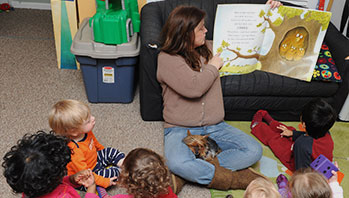- absorb
- drip
- drop
- float
- flow
- pour
- puddle
MA Standards:
Literature/RL.PK.MA.1: With prompting and support, ask and answer questions about a story or a poem read aloud.
Literature/RL.PK.MA.10: Listen actively as an individual and as a member of a group to a variety of age-appropriate literature read aloud.
Literature/RL.PK.MA.9: With prompting and support, make connections between a story or poem and one’s own experiences.
Head Start Outcomes:
Literacy Knowledge/Book Appreciation and Knowledge: Asks and answers questions and makes comments about print materials.
PreK Learning Guidelines:
English Language Arts/Reading and Literature 6: Listen to a wide variety of age appropriate literature read aloud.
English Language Arts/Reading and Literature 10: Engage actively in read-aloud activities by asking questions, offering ideas, predicting or retelling important parts of a story or informational book.
Read Together: Ten Dirty Pigs/Ten Clean Pigs

© Commonwealth of Massachusetts, Department of Early Education and Care (Jennifer Waddell photographer). All rights reserved.
STEM Key Concepts: Wet things become dry as water evaporates (changes from a liquid to a gas)
ELA Focus Skills: Concepts of Print, Listening and Speaking, Making Connections, Story Comprehension, Vocabulary
Before You Read
Tell children you are going to read a silly story about ten pigs that clean themselves up and then get dirty again. Hold up the book and read the title: Ten Dirty Pigs: An Upside-Down, Turn-Around Bathtime Counting Book. Ask children what they think the story will be about. After children have responded that the book is about ten dirty pigs or a counting book or a bathtime book, etc., ask, What do you think an “Upside-Down, Turn-Around” book is? Let’s read and find out.
Set a listening focus by having children look for all the different ways water moves in the story.
As You Read
Read slowly and with a playful expression, emphasizing the rhyming words.
As you read, point to the different ways the water moves in the illustrations.
- Point to the water flowing out of the faucet (1/2 pigs spread)
- Point to the water drops (3/4 pigs spread)
- Point to the water pouring out of the containers (3/4 pigs spread)
- Point to the water drops (5/6 pigs spread)
- Point to the splashes (9/10 pigs spread)
When you finish the ten dirty pigs story, make a big deal of closing the book shut, holding the book up, and flipping it over to the Ten Clean Pigs side. Say, So, that’s what an Upside-Down Turn-Around book is! Flip it a few times so children can see the dirty/clean pigs.
- Continue and read the Ten Clean Pigs in the same way by pointing to the different ways the water moves on each spread.
After You Read
- Do a picture walk as children point out all the ways they notice water flowing and water drops dripping. Encourage them to use descriptive vocabulary such as absorb, flow, drip, drop, float, and puddle as they describe the illustration.
- Ask, What things did you notice in the book that were similar in your explorations with water this week? Again, encourage the use of descriptive vocabulary.
